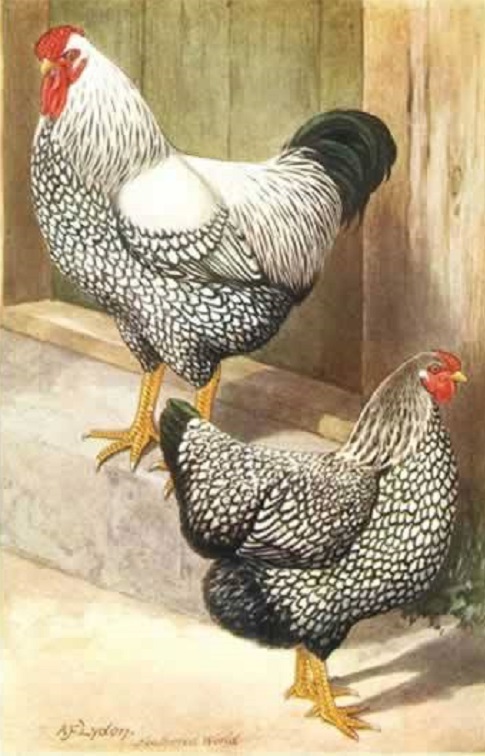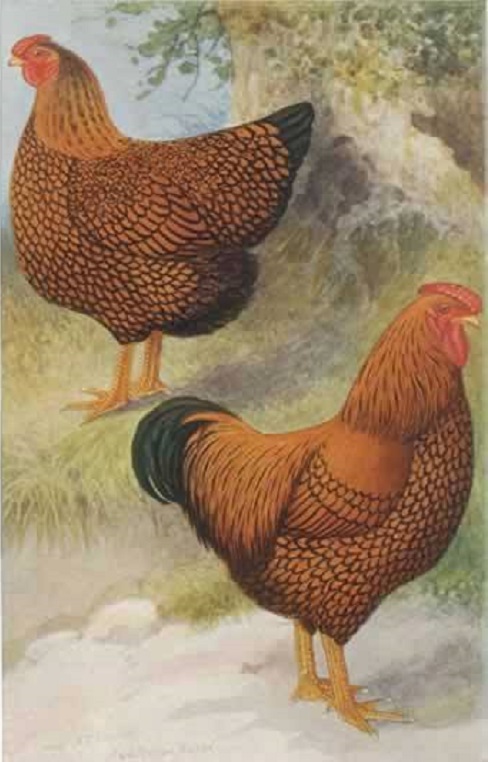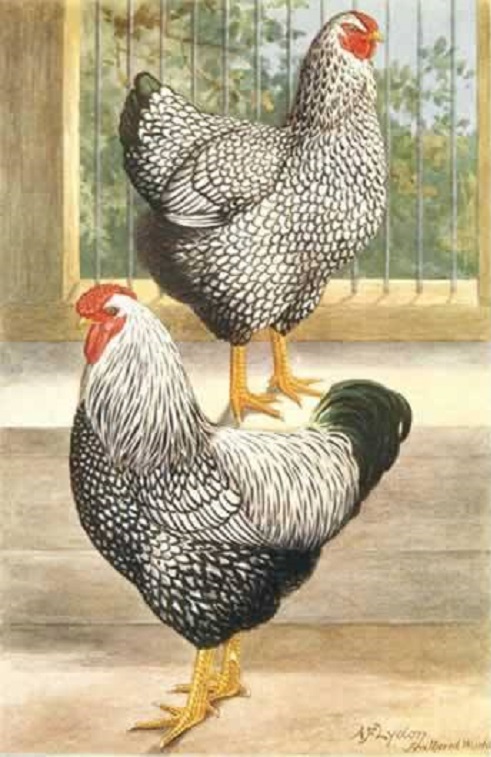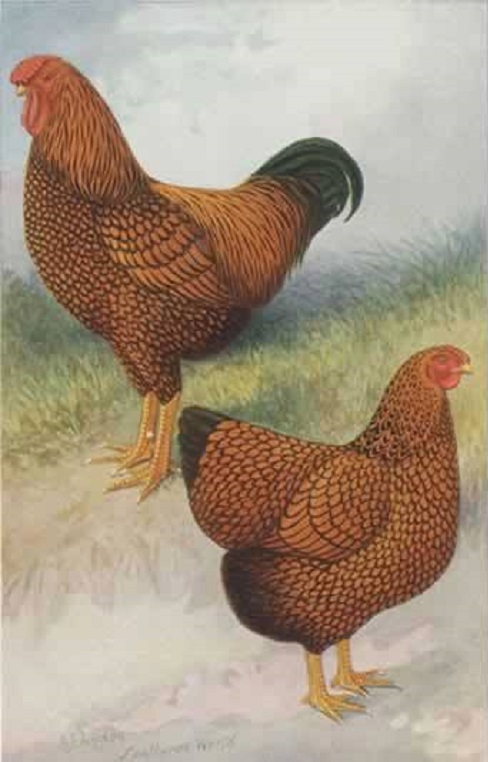Double Mating
The following is taken from Wyandottes and All About Them by Richard F. Spencer, originally published in 1900.
BREEDING SILVER AND GOLDEN WYANDOTTE
IN the books that have previously appeared on the Wyandotte, I have noticed several different matings recommended for the production of exhibition stock, and in almost every instance a dark or almost black-breasted cock has been advocated. This has been done, I presume, on account of the supposed liability of the Wyandotte to lose colour. Now in theory this sounds very well, and I have not the least doubt the various writers believed implicitly all they had written, but in practice I am afraid the very dark-breasted cock is a little bit of a fraud, and will not do half that his advocates claim for him. In proof of this I will give the opinion of Mr. F. Houdlette, one of the chief movers in the introduction of the Silvers tin America, where he says they are still breeding from rather dark-breasted cocks. But on his visit to this country, after having inspected a great number of our best birds all bred more or less on the lines advocated in this work, he informed me that he did not think before seeing these that it would ever be possible to produce such breast and wing lacing as had already been achieved in this country. He stated that in this particular English birds were a long way in advance anything he had seen on the other side, although in shape and top colour he thought they could beat us. I claim that this advance is entirely due to breeding from cocks with jet-black, clean cut, open lacing. At any rate, in breeding cockerels, I have found the very dark cock a complete failure, as the chicks always come too solid in breast, and also, as a rule, sooty in saddle and hackle. I quite agree that colour must not be lost, but I contend that it can be maintained with quite as great certainty and with much greater safety by breeding from dark hens mated with a medium, or, in fact, a comparatively light cock, provided his lacing be pure black and his under-colour good. It does not necessarily follow that because a cock has a solid breast, the colour must consequently be good, for I have seen many birds with very heavy lacing which on close examination have proved to be ticked or double laced all down, and, moreover, the black instead of being pure has generally been of more or less brown shade. Therefore I cannot at all understand how that class of bird can be expected to preserve colour more than a lighter bird that is pure in lacing. My own experience has been that the lighter bird with pure lacing is far ahead when good cockerels are required, although a dark bird is useful for pullet breeding, but even for this purpose I do not care for the breast to be too solid in markings.
I will now describe the birds I should like to mate together for each purpose, and I will preface my remarks by stating that these coatings are the result of my own experience and not a theory that I have never proved. These remarks apply equally to Silver and Gold so far as lacing is concerned, but in mating Golds care should be taken that the ground-colour of both sexes should be rich and bright, and in hens for cockerel breeding the lacing on cushion should be rather close, giving rather a dark appearance, and the shafts and centres of the feathers should be rich bay and not, as is too often the case in these dark-looking hens, a pale yellow or almost straw colour.
The Wyandotte, in common with other varieties of laced fowls, requires a great amount of care in mating to produce high-class specimens, and anyone who wishes to get near the top of the tree must be prepared to suffer many disappointments before he can hope to arrive there, as there are so many details in breeding that can only be mastered by practical experience and very close study of the breed.
I consider the first thing to be done is to try and found a strain and, in order to do this, it is absolutely necessary that the birds selected for the breeding pens should all be of the very best blood obtainable; and it is also better to start with two pens than one, as, although by judicious selection really high-class birds of both sexes can be produced from the same pen, there is a much better chance of success if the sexes are bred separately. To commence with
THE COCK-BREEDING PEN,
which I consider of the most importance, a cock should be obtained from a good cock-breeding strain. I lay great stress upon this point, for there are some strains that will throw many good pullets, but not one per cent of really high-class cockerels, and vice versa. The hens to match should be of the same strain as the cock, but not closely related, or size may be lost, which would be a great pity, as a big Wyandotte of good quality is much more valuable than a small one of the same quality.


Silver and Gold Laced cock breeders
These images are from prints published by ‘Feathered World’.
Size is of great importance, and therefore the hens bred from should always be big ones, although an average-sized cock is as valuable for breeding purposes as an extra large one.
Now for a description of the birds I would select. The cock should be of good size, with neat head and comb, following well the curve of the back of the head; ear-lobes and face bright rich red, without any tendency to white in lobes, as this is very difficult to breed out when once introduced into a strain. The neck should be of fair length, with fairly-full hackle of pure silver with a black stripe down the centre of each feather. The body should be broad, as it is never advisable to breed from a narrow-chested bird. Be very careful that the top-colour throughout is of pure silvery sheen and quite free from rusty straw colour or soot, as these are two faults it is next to impossible to eliminate from a strain.
The breast should be full and nicely rounded, and the legs of medium length; a very short-legged bird never showing himself in a pen to the best advantage. Colour, bright orange.
The lacing pure black and white, sharply defined, and free from double or outer lacing; running well round the feather, and extending from throat well down to the thighs and hocks, with a little distinct lacing on the fluff, and it should be fairly open, or you will get a deficiency of breast-lacing in the cockerels. The tail should be free from white, and the whole of the ground-colour a sound black. Never breed from a bird with peppery thighs, or one that is spangled at the bottom of the breast.
The bars should extend right across the wing, the lacing running well round the feathers, and it must be distinct and free from spangling.
In choosing hens to mate with a cock of the above description, a dark type of bird should be selected. The breast lacing should be rather heavy, as free as possible from double lacing, and it should run right up to the throat and down to the thighs, with a few distinct stripes on the fluff. The hackle should be clear and silvery, and quite free from soot, but should be rather heavily striped. Be sure that the black is pure throughout, as there is always a tendency to a brown shade in Wyandotte hens; the under-colour must also be sound. Select hens with as good bars and wing-lacing as possible. A little moss in the cushion does not so much matter in cock breeding, provided the outer lacing be sound black.
In describing the hen as above I allude to their pullet-feathers, for when a cook-breeding Wyandotte hen has once moulted her adult plumage, she generally comes out very mossy all over, sometimes the moss even extending to the breast; and her black sometimes turns a dull brown. However, she need not be discarded on this account, as she will always breed back to her pullet feathers.
THE PULLET BREEDING PEN
As a proof of this I can quote an instance, and one that also goes to prove the potency of some hens in their influence on the colour properties of their progeny. We .had in our yards a hen that we bred from for four seasons. As a pullet she was a sound good black and. white, in fact, looked a first class cock-breeder, but when she moulted she came out rather a dingy brown and her former clear lacing became blurred and indistinct, and altogether she looked worth about five shillings. However, we were so well pleased with the cockerels she bred the first season that we determined to try her again, and the result was very satisfactory. She was mated with four different cocks, and from each one produced winners at leading shows. Therefore, I say, do not discard a good breeding pullet because she moults out badly.


Silver and Gold Laced Pullet breeders
These images are from prints published by ‘Feathered World’.
In selecting birds for pullet-breeding the cock should be darker than the one used in the last pen, and he should come from a pullet-breeding stock. He should be perfectly sound in under colour and fluff, his breast lacing should be pure, rather heavy, and plentiful. The hackles should be clear, but somewhat heavily striped, the back and wings should be pure in colour, the bars distinct but rather heavy, with a nice lot of lacing on the flights. The tail should be pure black.
Now comes a point that I would call special attention to. Before deciding to use a bird for pullet-breeding, lift up the saddle hackle near the tail, and see that the secondary tail-coverts have pure white (or bay in the Golden variety) centres; or in other words, are pullet-laced. If so, that is the one that will breed the clearest-cushioned pullets. If a bird has this lacing and is good in other points, I would even permit a little white in sickles, rather than discard him; for, although I strongly object to white in tail, I do not consider that it is quite so serious in mating up for pullets as it is in the lord of the cockerel-breeding pen. The mates for such a bird should be absolutely free from moss in cushion, if such can be found, clear and distinct in lacing all over, and be sure that the lacing is pure black, as there is a great tendency to brown or grey in most pullets. The lacing should extend right round the feather. Do not, if it can be avoided, breed from pullets or hens that are patchy on shoulders.
The hackles to match the cockerel described should be clear, and the tail sound black; especially if there is a little white in the cook’s sickles this must be insisted on, in order to counteract this fault. The thighs, fluff and under-colour should be sound in all stock birds, as a light fluff will be perpetuated for generations. It is always preferable to breed from pullets that are a little too dark for the Show pen, provided they are free from moss in cushion, rather than those with very light lacing; but a lighter laced pullet, if quite sound in fluff and under colour, will, if mated to rather a dark cock, generally produce some good stock.
When selecting hens to mate with a cockerel, such as described above, it is as well to pick out birds that are not all of one shade, but some darker and some lighter than the standard, as one can never be quite certain what particular depth of lacing in the hens may just suit that of the cockerel, to produce the best results.
Another point that I would notice is the difference in the shade of different strains, for a dark pullet from a light strain will often produce lighter chicks than a comparatively light pullet that is descended from a dark strain. Never breed from any hens or pullets whose lacing is half-moon shaped, or does not extend right round the feather.
All the birds in the breeding pens should have rich orange legs free from black or green spots or sooty toes. These faults are nearly always reproduced in the chickens. The combs should be small, and lie close to the head, quite distinct from the Hamburgh type, which is very objectionable.
Care should be taken that every bird in the pens, whether young or old, be strong and vigorous, as no good can result from mating up weakly specimens, and I would not advise too many hens in a pen, for it is much better to breed from a few hens of merit than to fill up with second-raters, because you think you have not enough good ones; and further, every hen should be in some way related to the cock she is running with, if you wish to produce uniformity of type in the young stock.
I do not advocate too close in-breeding, but, provided the birds be big and strong, a little of it does no harm. In fact, I do not believe that really high quality and uniformity of lacing can be maintained without it. When a change of blood is necessary, introduce it through a hen, which can best be done by buying a good hen to put in pen, and selecting the best cockerel bred from her and mating him with suitable hens or vigorous pullets bred from same sire; or half sisters to him. In this way many of the best Wyandottes that have yet been before the public have been produced.
I would also remark that there is a great tendency in Wyandottes to throw back, and it is therefore essential when buying birds for change of blood to enquire closely into their antecedents, or a really good strain may be practically ruined for several years by one injudicious step in this direction, especially if the change be introduced through a cockerel.
If a person has only room for one pen I should advise that one or two hens that are rather more open in their lacing than the hens in No. 1 pen be put in to it, taking care that they are perfectly clear and open in the cushion-lacing, and quite free from a mossy tendency. From such a pen both cockerels and pullets of merit may be bred, but it is much better to start with two pens, as you thus have an opportunity of securing change of blood when necessary.
As a proof that good cockerels and pullets can be bred from the same pen, I may mention that the first Dairy cockerel and the third Palace pullet (Silvers) of 1895 were bred from the same pen.
To sum up my ideas of breeding in a few words, I should, if cockerels are required, breed from a cock as near to standard quality as it is possible to get, mated with stock hens, as described above, and if pullets are required, the hens should be as near the standard as possible, mated with cock as described in pen No. 2.
If the mating recommended above be carefully followed, I have little doubt of its ultimate success.
In every case be sure that the under-colour of both cocks and hens is sound, for this is the foundation upon which the colour throughout the offspring depends.